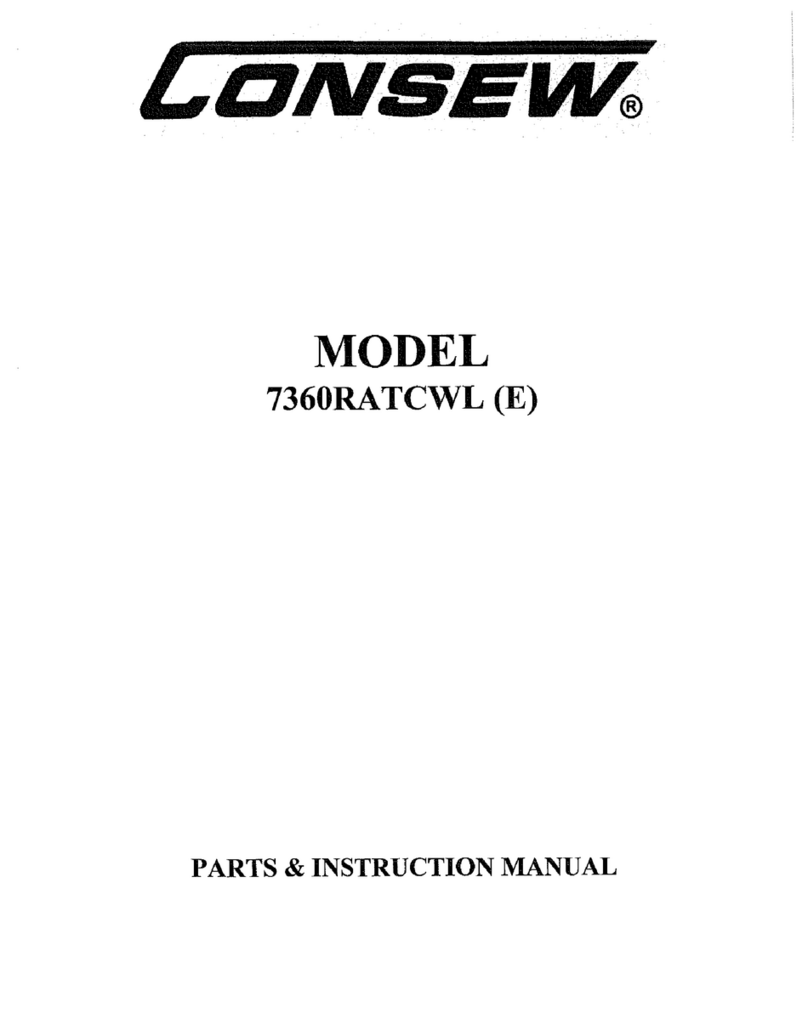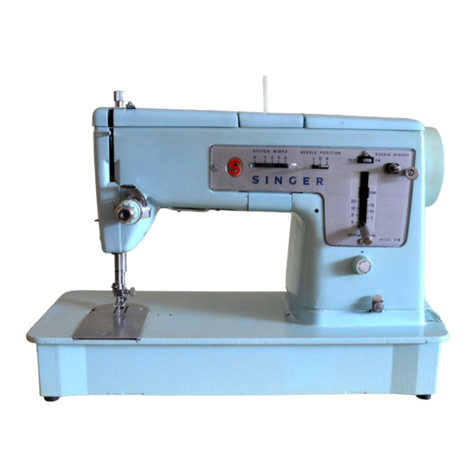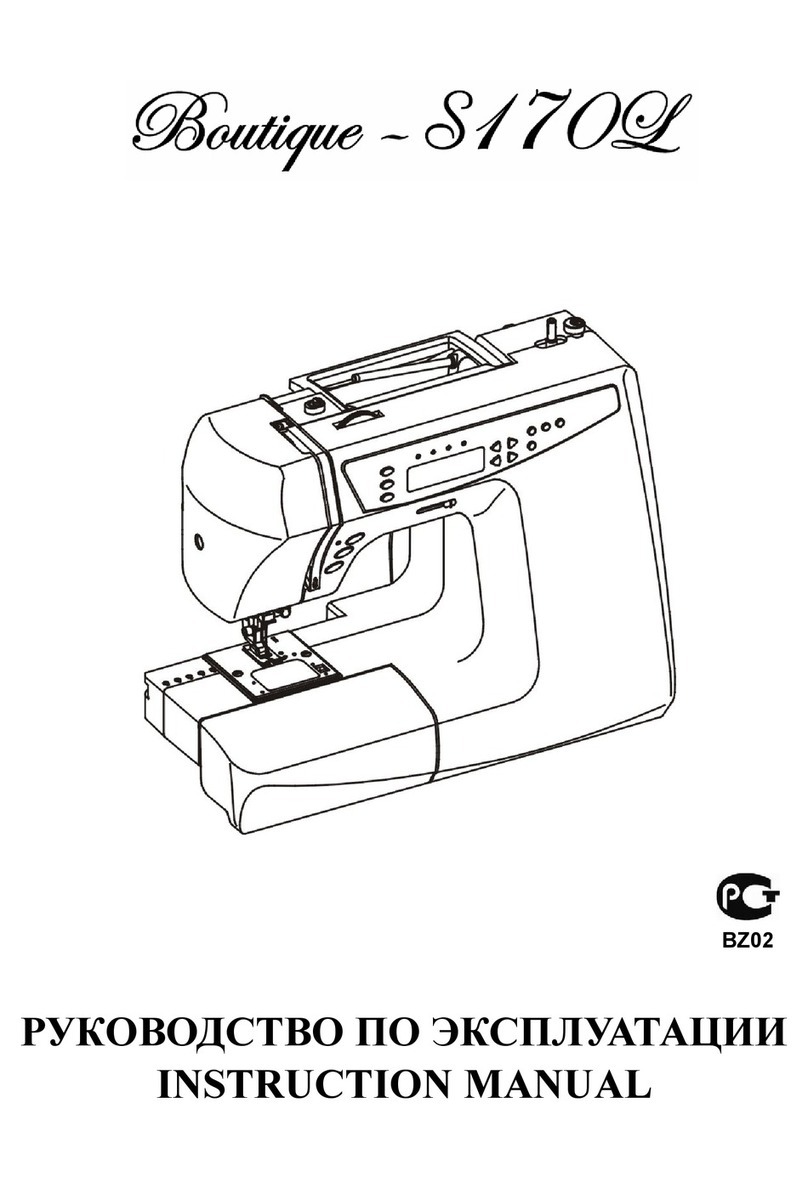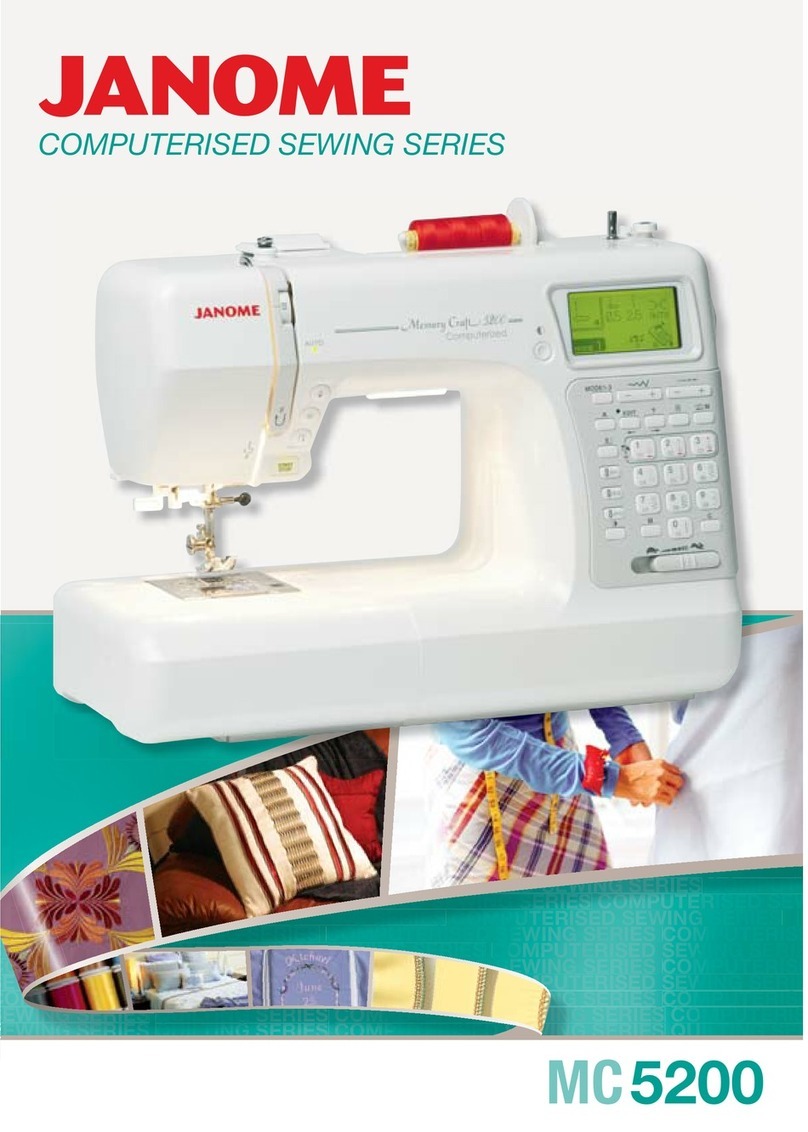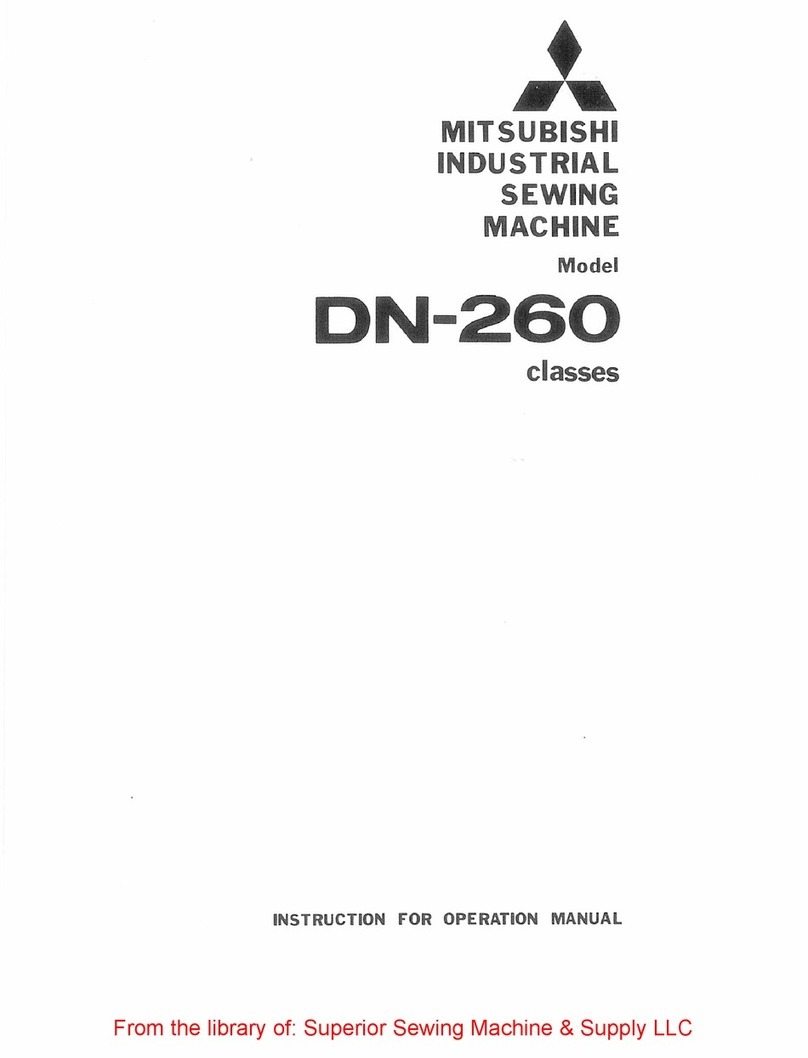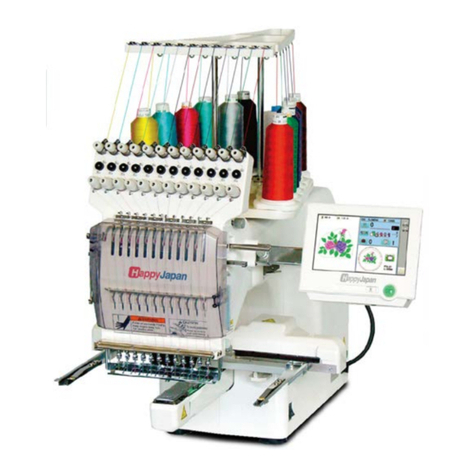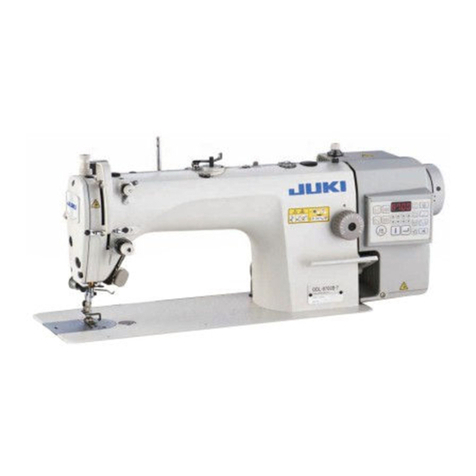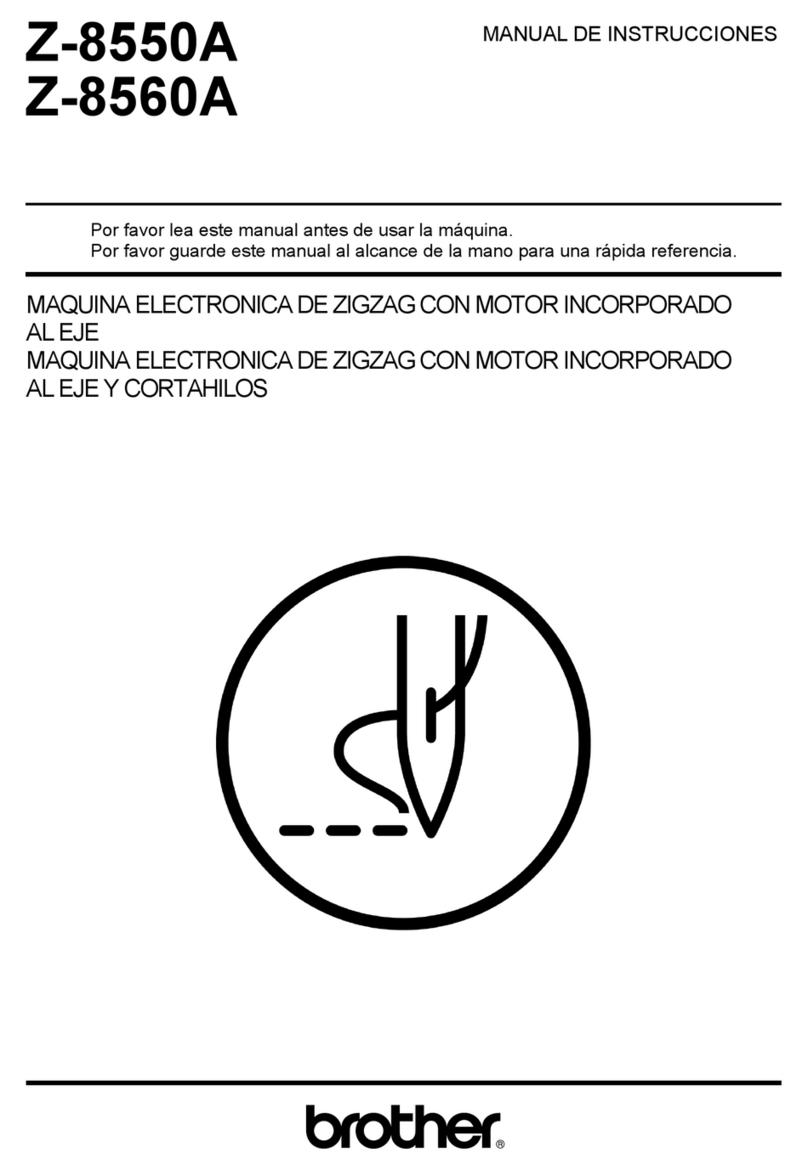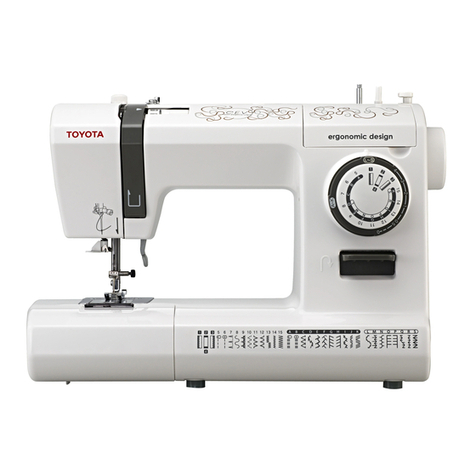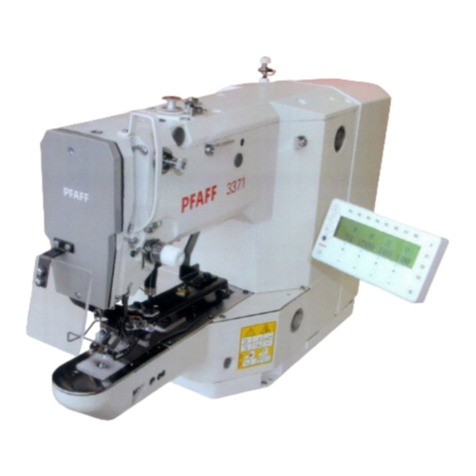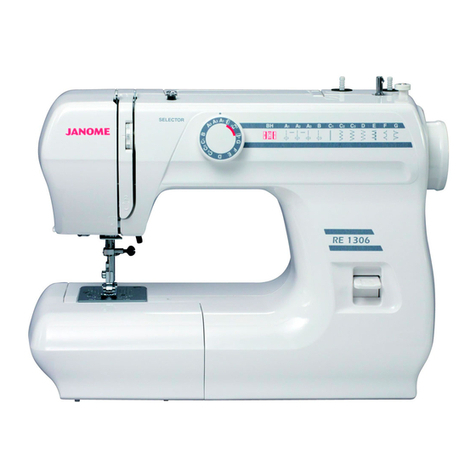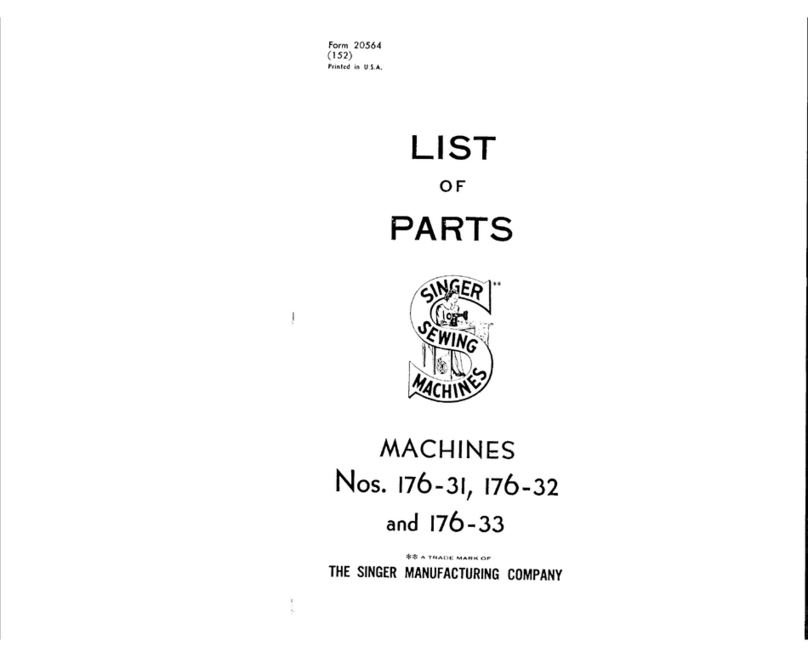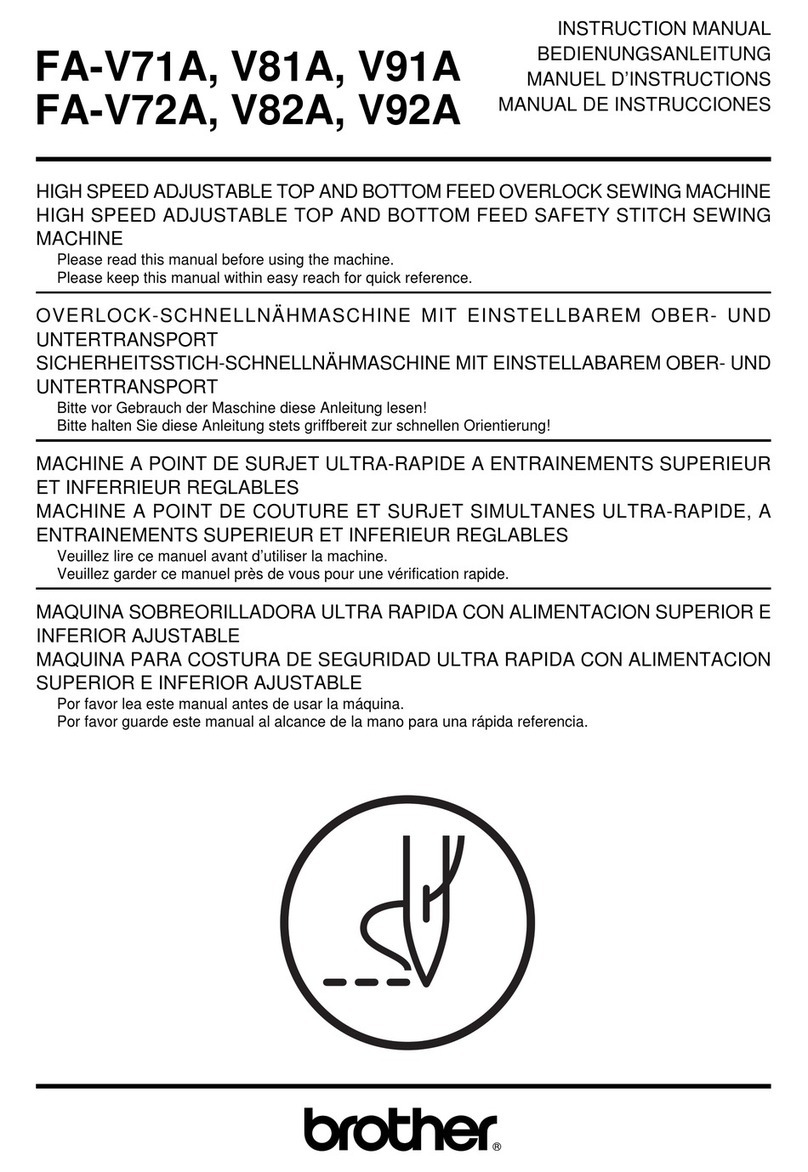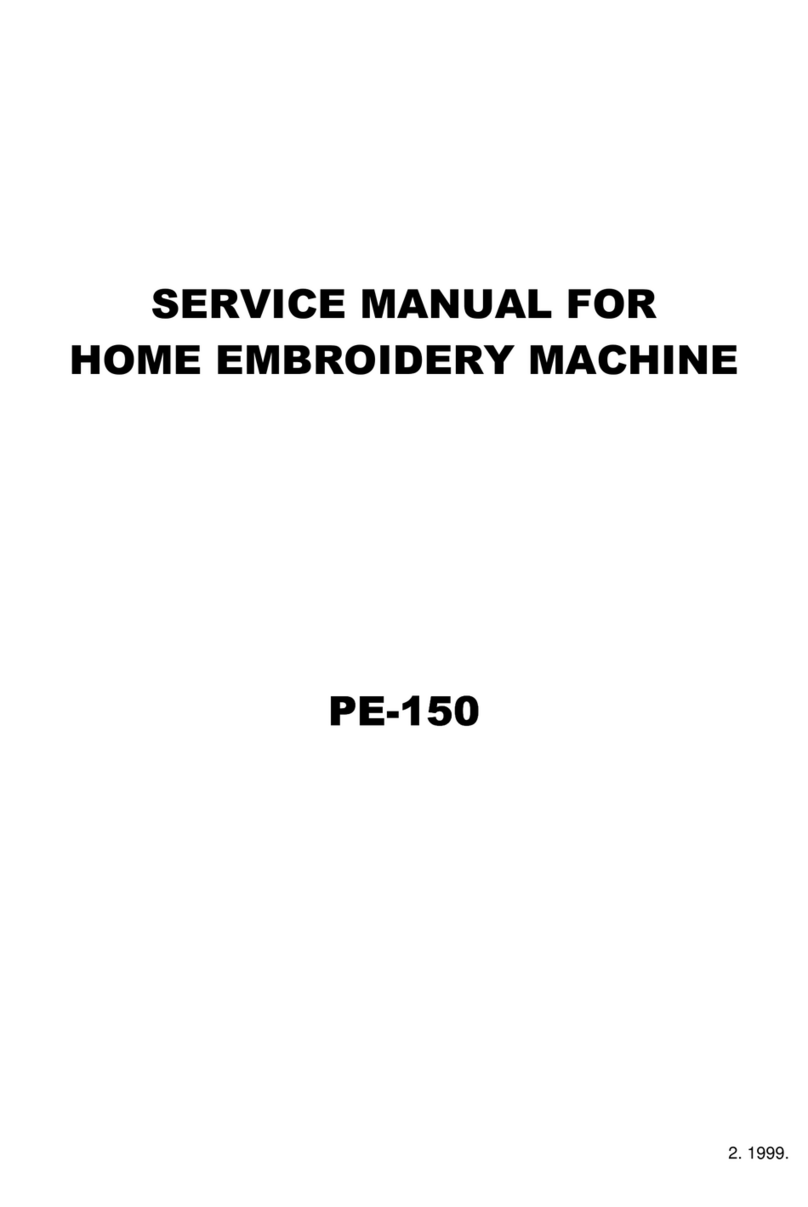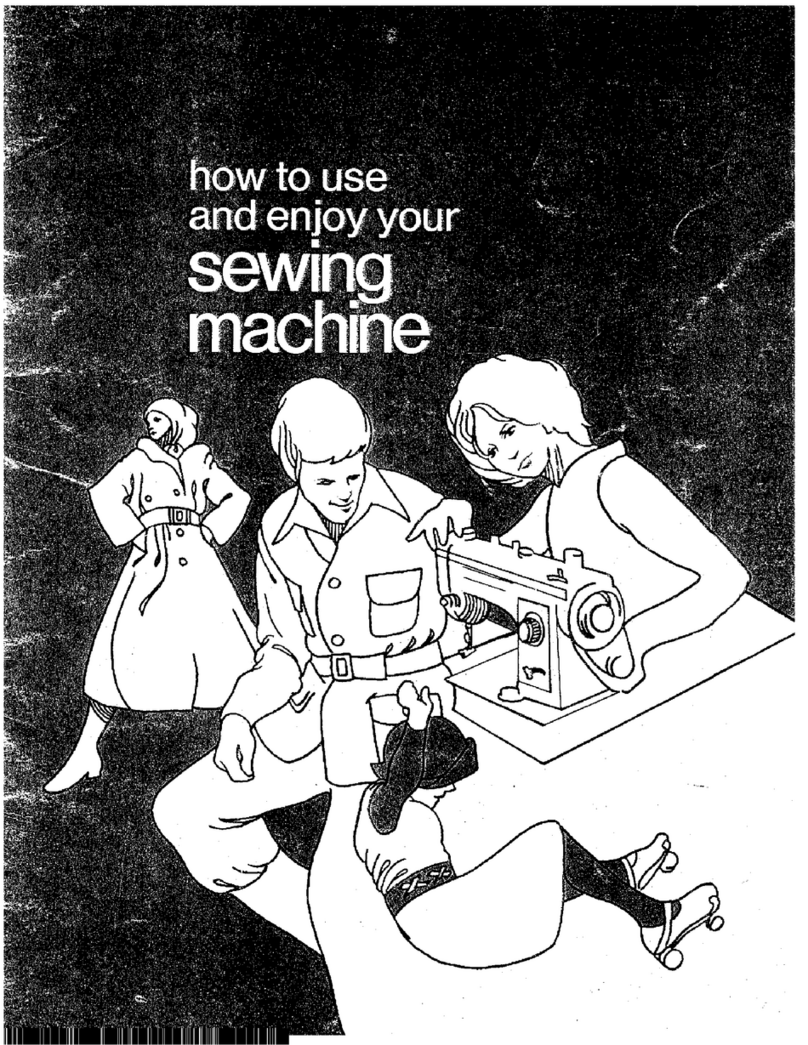Tesco MSM 10 User manual

USER GUIDE
Mini Sewing Machine
MSM 10

Please follow all the precautions listed below for safety and to reduce the
risk of re, injury or electrical shock.
Read all the instructions before operating the appliance and keep them for future
reference. If you pass the product on to a third party, include these instructions.
Always unplug the sewing machine AC adapter from the mains supply when removing
covers, lubricating, or when making any user or servicing adjustments mentioned in
the instruction manual.
Ensure there is adequate room to operate the unit.
Never operate this appliance if the AC adapter or cord is damaged, if it is not working
properly, if it has been dropped or damaged, or dropped into water. Return the appli-
ance to a service centre for examination, repair, electrical or mechanical adjustment.
This appliance is not intended for use by persons (including children) with reduced
physical, sensory or mental capabilities, or lack of experience and knowledge, unless
they have been given supervision or instruction concerning use of this appliance by a
person responsible for their safety.
Children should be supervised to ensure that they do not play with the appliance
Do not use outdoors or in damp or wet conditions.
Before operating, ensure that the surface on which the unit is placed is stable.
Never operate the appliance with any air openings blocked. Keep all ventilation
openings of the sewing machine and foot controller free from accumulations of lint,
dust, and loose cloth.
Do not insert any object into ventilation slots.
Keep ngers away from all moving parts. Special care is required around the sewing
machine needle.
Do not use broken, deformed or blunt needles.
Do not pull or push fabric while stitching. It may deect the needle causing it to break.
Unplug the sewing machine adapter from the mains supply when making any
adjustments in the needle area, such as threading the needle, changing needles,
threading bobbins, changing the presser foot and the like.
Do not operate where aerosol spray products are being used or where oxygen is being
administered.
This appliance is only for household use. Industrial or professional use will invalidate
the warranty.
Do NOT use this appliance for any purpose not covered by the instructions.
THE APPLIANCE MUST NOT BE LEFT UNATTENDED WHILE IT IS CONNECTED TO THE
SUPPLY MAINS.
ELECTRICAL INFORMATION
Before using this appliance ensure that the voltage of your electricity supply is the
same as that indicated on the appliance.
The means of disconnecting this appliance from the mains supply is the mains
adapter.This should be unobstructed and readily operable at all times.
IMPORTANT SAFETY GUIDE
Page 2
May we suggest that before you start to use your sewing machine, you discover its many features and
advantages by going through this instruction book, step by step, while seated at your sewing machine.
This symbol indicates that there are important operating and
maintenance instructions in the literature accompanying this unit.

Safety Guide Page 2
Details of the machine Page 4
Standard Accessories Page 5
Connecting the Machine Page 5
Attaching and removing the needle Page 6
Winding the bobbin Page 7
Inserting the bobbin Page 9
Threading the machine Page 10
Bringing up the bobbin thread Page 11
Adjusting the needle thread tension Page 12
Adjusting the stitch length and pattern Page 13
Basic sewing Page 14
More about Stitching Page 15
Maintenance Page 16
Troubleshooting Page 17
Appendix - Matching the needle, fabric and thread Page 18
After Use Page 19
Care Page 19
Warranty Page 19
CONTENTS
Page 3

1 Bobbin winding tension disk
2 Upper thread guide
3 Thread take-up lever
4 Thread tension dial
5 Needle plate
6 Hook cover plate
7 Reverse stitch lever
8 Stitch selector
9 Needle Clamp screw
10 Needle bar thread guide
11 Needle
12 Presser foot
13 Setscrew
14 Bobbin winder spindle
15 Bobbin winder stopper
16 Handwheel
17 Foot switch jack
18 AC adapter jack
19 Presser foot lifter
20 Spool pin
Page 4
DETAILS OF THE MACHINE

STANDARD ACCESSORIES
1 Bobbin
2 Needle
3 Threader
4 AC adapter
5 Foot switch
1 Foot switch plug
2 Foot switch jack
3 AC adapter plug
4 AC adapter Jack
5 AC adapter
6 Power outlet
A: Place the Foot switch in a comfort
able position on the oor.
B: Insert the foot switch jack into the
machine.
C: Insert the AC adapter Jack into the
machine.
D: Insert the AC adapter plug into the
mains point and switch on at the mains.
E: The foot switch switches the sewing
machine on and o. It does not adjust the
speed of the machine.
Press on the foot switch to start the machine.
Release the foot switch to stop the machine.
Your sewing machine is now ready for use.
Page 5
CONNECTING THE MACHINE
E

ATTACHING AND REMOVING THE NEEDLE
A: Raise the Presser Foot: The Presser Foot Assembly is raised and
lowered with the Presser Foot Lever (No.12 on P. 4). The positions are:
1. Foot fully lowered
2. Foot raised to normal height
3. Foot raised to the highest position
B: Raise the Needle: The needle is raised and lowered by rotating the
Handwheel (No.16 on P. 4) anticlockwise.
C: Replace the Needle.
This machine is tted with a Size 14 (90) needle. To sew light weight
fabrics you may need to change the needle. (rEFER TO pAGE xx)
1: Loosen the needle clamp screw with a small at bladed screwdriver.
2: Remove the needle. Do NOT touch the point!
3: Insert the needle with the at side towards the back. Push the needle
as far as it will go. Re- tighten the screw.
4: To check if a needle is bent, place the at side of the needle onto a
needle plate or lat mirror. The gap between the needle and the at
surface should be consistent.
D: Needles must be in perfect condition. Problems can occur with:
A. Bent needles: B. Blunt needles: C. Damaged points
Change the needle regularly, especially if it is showing signs of wear
and causing problems.
CAUTION: Always exercise care when attaching needles. Store needles
safely away from children and pets and dispose of them with great
care with the points protected.
ALWAYS swith the power o when attaching needles.
Page 6
A B
B A C
D
C1 C2

WINDING THE BOBBIN -1
The needle and take-up lever moves up and down while
winding the bobbin.
Keep ngers away from all moving parts. Special care is
required around the machine needle.
To avoid possible injury, do not touch any moving parts.
Your sewing machine works by stiching two threads.The main thread is
contained on the spool of thread which is placed at the top of the machine.
A second thread is contained in a compartment under the machine.This
thread is wound onto a“bobbin”from the main spool.
A: Place the spool of thread on the Spool Pin.
1: Pull out the spool pin stored in the back of the sewing machine.
2: Prepare the spool. The thread should protrude from the spool.
3: Place the spool of thread on the spool pin.
B: Remove the Bobbin.
1: Slide the hook cover plate toward you and remove it.
2: Lift the bobbin out of the bobbin holder.
3: Place the spool of thread on the spool pin.
Page 7
A
B1A
B2

WINDING THE BOBBIN -2
C: Draw thread from the spool. Guide the thread around and under
the thread guide. Draw out the thread from the notch and pass it
under the disc.
1: Thread guide
2: Notch
3: Disc
4: Bobbin on Bobbin Winder Spindle
D: Push the Bobbin spindle to the left. Lead the thread through the hole
in the bobbin from the inside. Place the bobbin on the bobbin winder
spindle. Push the bobbin to the right.
E: With the free end of the thread held in your hand, depress the foot
switch. The motor will start and begin to wind the oibbin
After the bobbin has wound for about 10 seconds, stop the machine and
cut the thread close to the hole in the bobbin.
F: Depress the foot switch again.When the bobbin is fully wound, it stops
automatically. Return the bobbin winder to its original position by
moving the spindle to the left, and cut the thread.
C D
E F
Page 8

INSERTING THE BOBBIN
1: Orient the bobbin with the thread running to the left.
2: Place the bobbin in the bobbin holder.
3: Guide the thread into the notch on the front of the bobbin holder. The
dotted line on the illustration shows the correct thread direction..
4: Draw the thread to the left, sliding it between the tension spring blades.
5: Continue to draw the thread lightly until the thread slips into the notch on the
side. The bobbin should rotate freely.
6: Pull out about 10 cm (4”) of thread to the rear.
7: Reattach the hook cover plate.
Inserting and threading the bobbin is much easier when the needle is
fully retracted and the presser foot raised. See Page 6 for details.
Page 9

THREADING THE MACHINE
This operation is important to carry out correctly as by not doing so many
sewing problems could result. We suggest you read through the procedure
carefully and carry out this process several times before using the machine to
familiarise yourself with the process.
Disconnect the AC adapter from the machine before threading.
Raise the thread take-up lever to its highest position by turning the
handwheel counterclockwise. Raise the presser foot.
Place a spool on the spool pin, with thread coming o as shown.
1: Draw the end of thread around under the thread guide.
2: Hold the thread close to the spool with your right hand. Use your left hand
to draw the end of the thread down along the right channel and around
the bottom of the guide plate.
3: Firmly draw the thread up along the left channel. Pass the thread through
the eye of the take-up lever from right to left.
4: Draw the thread down along the left channel and pass it behind the needle
bar thread guide from the left.
5: Thread the needle from the front. Pull the thread through the needle eye.
USING THE SUPPLIED THREADER LOOP
5: Insert the threader loop through the needle eye from behind.
6: Pass the thread end through the threader loop. Pull the threader loop out
from the needle eye. Remove the thread end from the threader loop.
Page 10
TAKE-UP LEVER
THREAD
GUIDE

BRINGING UP THE BOBBIN THREAD
Refer to Figure 1
1: Raise the presser foot. Hold the needle thread lightly with your left hand and
rotate the handwheel counterclockwise, toward you, for one complete turn.
Hold the upper thread LOOSELY with the left hand.
Turn the handwheel forwards to lower and then fully raise the needle.
Refer to Figure 2
The upper thread will catch and raise the lower thread.
1: Pull on the upper thread to bring the lower thread up through the stitch plate
hole.
2: Pull the lower thread up fully .
Refer to Figure 3
Pull both threads 4”to 6”(10 to 15 cm) under and behind the presser foot.
The sewing machine is now ready for use.
Page 11
Figure 1
Figure 2 Figure 3

ADJUSTING THE NEEDLE THREAD TENSION
Rotate the dial to adjust the upper thread tension
The basic thread tension setting is“4”
To increase the tension, turn the dial to the next number up.
To reduce the tension, turn the dial to the next number down.
The tension requires adjustment depending on:
- stiness and thickness of the fabric
- number of fabric layers
- type of stitch
The opposite diagram shows the eects of dierent thread tension settings:
A. Normal thread tension: The ideal straight stitch has threads locked evenly
between two layers of fabric, as iIIustrated.
B. Upper thread tension too loose: If the needle thread shows through on the
wrong side (bottom side) of the fabric, turn the dial to a higher number to
tighten the needle thread tension.
C. Upper thread tension too tight: If the bobbin thread shows through on the
right side (top side) of the fabric, turn the dial to a lower number to loosen the
needle thread tension.
Page 12
Balanced (Normal) Tension
3: Needle thread (Top thread)
4: Bobbin thread (Bottom thread)
5: Right side (Top side) of fabric
6: Wrong side (Bottom side) of fabric

ADJUSTING THE STITCH LENGTH AND PATTERN
STITCH SELECTION
To avoid needle or fabric damage, make sure the
needle is fully raised before selecting a stitch.
1; Raise the needle above the fabric.
2: Select the desired stitch length/pattern by rotating the Stitch Selector until the
appropriate letter aligns with the setting mark at the top.
3: Follow the Stitch Setting Guide to set your machine for the desired result.
A Note on ZIgZag stitching tensions
1: For an ideal zigzag stitch, the bobbin thread
does not show on the right side (top side) of the
fabric and the needle thread shows slightly on the
wrong side (Bottom side) of the fabric.
A
B
C
D
E
F
G
H
A B C D
E F G H
SYMBOL LETTER STITCH CARD
SETTING MARK
Stitch Setting Guide
A-D: Straight Stitch - Centre Needle Position.
There are 16 positions from letter A-D.This allows you to
ne-tune the stitch length from ne to extra long.
E: Straight Stitch - Right Needle Position, Medium Stitch
Stitch length in this position is the same as letter C above.
F-H: ZigZag Stitch.
Three settings, each letter selects one preset stitch length
Page 13

BASIC SEWING
STRAIGHT STITCH
Stitch selector and Needle thread tension as shown
NOTE: The stitch length of pattern E is the same as C.
A: Starting to sew
Raise the presser foot and position the fabric on the needle plate.1.
Lower the needle at the point where you want to start.2.
Lower the presser foot and pull the threads to the back.3.
Depress the foot switch.4.
Gently guide the fabric, letting the fabric feed naturally.5.
B: Securing a seam
To fasten the beginning of a seam, press the reverse stitch lever and sew several1.
reverse stitches before you start.
Release the lever and the machine will sew forwards.2.
C: Finishing sewing
Press the reverse stitch lever and sew several reverse stitches to fasten the seam.1.
Lift your foot o the pedal to stop the machine2.
Turn the handwheel towards you and fully raise the needle.3.
Raise the presser foot.4.
Remove the fabricto the back and left of the machine and cut the threads.5.
Page 14
A B D E
C
Tension 2-6
A
B
C

MORE ABOUT STITCHING
Turning a Corner
Stop stitching at the corner of the fabric.1.
Raise the needle by turning the handwheel counterclockwise.2.
Raise the presser foot and turn the fabric counterclockwise through the3.
desired angle
Lower the presser foot and begin stitching in the new direction.4.
ZIGZAG STICHING
The zigzag stitch is one of the most common and versatile stitches. It can be a
utility stitch for hemming, overcasting, mending and darning. It can also be used
for appliques or as a decorative stitch.
Overcasting With A Zigzag Stitch
Select a pattern, which is suited for your sewing1.
needs from the 3 patterns available.
Set the tension.2.
Finish the raw edge of the fabric to prevent it from fraying.3.
Start overcasting about 1/8”(0.3 cm) inside the raw edge of the fabric.4.
The stitches on the right should just clear the fabric edge. Refer to the5.
illustration for guidance
Page 15
F G H
Tension 2-5

MAINTENANCE
Disconnect the machine from the power supply by unplugging the adapter from
the mains socket and then from the machine..
Cleaning the Bobbin Holder
CAUTION:
Remove the hook cover plate by sliding it toward you.1.
Lift out the bobbin.2.
Brush out dust and lint with a amall paint brush or a vacuum cleaner3.
brush
Insert the bobbin and attach the hook cover plate.4.
Page 16
1
4
2
3

TROUBLESHOOTING
If your machine is not working saftactorily, please work through this checklist before returning it to Tesco or taking it for service.
Page 17
Problem Probable Cause
The needle thread breaks.
1. The needle thread is not threaded properly.
2. The needle thread tension is too tight.
3. The needle is bent or blunt.
4. The needle is incorrectly inserted.
5. The needle thread and the bobbin thread are not set properly under the presser foot at the beginning of sewing.
6. The threads are not drawn to the rear after nishing sewing.
7. The thread is too heavy, or too ne for the needle.
The bobbin thread breaks.
1. The needle is incorrectly inserted.
2. The needle is bent or blunt.
3. The needle clamp screw is loose.
4. The needle thread tension is too tight.
5. The threads are not drawn to the rear after nishing sewing.
6. The needle is too ne for the fabric being sewn.
Skipped stitches
1. The needle is incorrectly inserted.
2. The needle is bent or blunt.
3. The needle and/or threads are not suitable for the work being sewn.
4. The needle thread is not threaded properly.
5. The wrong needle is used.
Seam puckering
1. The needle thread tension is too tight.
2. The needle thread is not threaded properly.
3. The needle is too heavy for the fabric being sewn.
Fabric jams or does not feed though properly 1. The fabric is too thick.
The machine does not operate. 1. The AC adapter or foot switch jack is not connected properly.
2. A thread is caught in the bobbin holder.
The machine is noisy 1. There is thread caught in the bobbin holder.
2. Lint has built up in the bobbin holder.

APPENDIX - MATCHING THE NEEDLE, FABRIC AND THREAD
Page 18
NEEDLE SIZE FABRICS THREAD
9-11(65-75) Lightweight fabrics -thin cottons, voile, serge, silk , muslin, interlocks, cotton knits,
tricots, jerseys, crepes, woven polyester, shirt & blouse fabrics. Light-duty thread in cotton, nylon or polyester.
12(80)
14(90)
Medium weight fabrics- cotton, satin, double knits, lightweight woollens.
Medium weight fabrics-cotton duck, woollen, terry cloth.
Most threads sold are medium size and suitable for
these fabrics and needle sizes.
Use polyester threads on synthetic materials and
cotton on natural woven fabrics for best results.
Always use the same thread on top and bottom.
IMPORTANT: Match needle size to thread size and weight of fabric
NEEDLE, FABRIC SELECTION
NEEDLES EXPLANATION TYPE OF FABRIC
HAx1 Standard sharp needles. Sizes range thin to large. 9 (65) to 18(110) (Max size
in this application 14(90)
Natural woven fabrics- wool, cotton, silk, etc.
Not recommended for double knits.
15x1/705H(SUK) Semi-ball point needle, scarfed. 9(65) to 18(110) (Max size in this application 14(90)
Natural and synthetic woven fabrics, polyester
blends. Knits-polyesters, interlocks, tricot, single knits.
Can be used instead of 15x1 for sewing all fabrics.
15x1/705H(SUK) Full ball point needle 9(65) to 18(110) (Max size in this application 14(90) Lycra, swimsuit fabric, elastic.
NOTES:
This machine is equipped with one #14 (90) needle only. Extra thick or tight-woven fabrics cannot be sewn with this machine.
Do not attempt to sew if the machine does not feed the material or the needle does not penetrate into the fabric.
NEEDLE, FABRIC, THREAD SELECTION

AFTER USE
Disconnect the machine from the power supply by removing the adapter from
the mains socket and then disconnecting the DC supply cord.
Remove the cord connecting the foot pedal.
Store the machine securely together with all accessories in a cool dry place away
from heat and damp and where it cannot be interfered with by children or pets.
CLEANING THE CASE
The case of the sewing machine may be cleaned with a barely damp cloth and then
dried thoroughly. Do not wet the appliance body, cord or mains plug. NEVER allow
water to penetrate the case or foot pedal.
CAUTION: Never use scouring pads, abrasives or harsh cleaners.
WARRANTY
YourTESCO appliance is covered by a warranty for 12 months from the date of
purchase. If a fault develops during this period, please contact the TESCO electrical
help line on 0845 456 6767. Please have your original purchase receipt with you
when you call.This warranty in no way aects your consumer rights.
SPECIFICATIONS
Voltage and Current Rating: 6VDC, 1200 mA - via power adapter
Adapter: 220 -240V AC, 50Hz in 6VDC out
Noise Performance ( SPL) : 75dBA
Net Weight: 6.1 kg
UK: Waste electrical products should not be disposed of with household
waste. Separate disposal facilities exist, for your nearest facilities. See
www.recycle-more.co.uk or in-store for details.
ROI: Produced after 13th August 2005. Waste electrical products should
not be disposed of with household waste. Please recycle where facilities
exist. Check with your Local Authority or retailer for recycling advice.
CONCLUSION
Page 19

Tesco Stores Ltd, Delamare Road,
Cheshunt, Herts, EN8 9SL
Table of contents
Other Tesco Sewing Machine manuals

